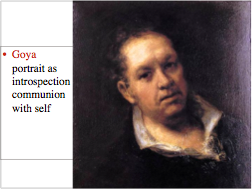Project leader: Larry Friedlander

Larry Friedlander's presentation on self-portraiture
Continuities and discontinuities. What happens when we look at social networking sites as contemporary portraits? What do we learn about how modern technology has transformed notions of identity? This is the question that will drive this project.
Who we are (identity) and how we present ourselves to the world and to ourselves (self representation) are not the same thing, but they are close. We become who we are by, in part, how we learn to image(in)e ourselves, how we combine the scattered pieces of our self into a package of some kind, a shape that says - at least for a moment - this is me. So when Rimbaud proclaims 'I is another' he stretches language to suggest how our self-understanding arises from a vertiginous leap outside of that self to the mirroring and competing world of others around us.
Traditionally, wealthy people found out who they were, or at least tried to make others see who they were, by having portraits painted: alone, with wife and family, with pets, with symbols of their trades and status, with a superior, or simply placed against the estates and rooms that reflected their importance. Painters assisted them in this project, but often insinuated slyly other views, less flattering to the subject's pretensions. When painters turned to depicting themselves they had more license to interrogate and deconstruct the images that they, or life, had fashioned. Rembrandt, Velasquez, Durer, Munch, Cindy Sherman, the names are legion of artists who saw in the self portrait not simply a feat of representation but an act of exploration of the dense connections between the inner and outer self, between the facades put together by biology and time and the interior shapes struggling to surface from their hiding places deep within. And as they explored this dynamic they turned the face towards the world, trying to control how they were seen but often subtly undercutting their own efforts by intimating that what you see is not necessarily what you get. The act of self-imagining is a game with self and with world.
Well, the world changes and so do the ways we have to make ourselves known. In the exploding field of electronic communication and imaging, portraits are now self managed affairs not only for artists. On sites such as Facebook and MySpace everyone gets to try assembling a 'face'. For what these sites provide are new ways of painting oneself for an audience.
Of course the medium is radically different - instead of oil and canvas we have the flickering and insubstantial computer screen. But this ephemeral, ghostlike screen is also the portal to an infinite number of other screens and self-representations: the photo we have uploaded and the accompanying text that tells others how to read this photo is only one moment in a unstable and unpredictable journey through multiple paintings and faces. Interactivity is the game, and the others that we face become the others that are also us: our friends are the mirrors of our self-understanding, and our negotiations with others the raw material out of which to make a self. Je est un autre!
Publications
Friedlander, L. (2011) 'Friending the Virgin. Some Thoughts on the Prehistory of Facebook', Sage Open [online] DOI:10.1177/2158244011415423
Friedlander, L. (2010) Sacred Geographies: Myth and Ritual in Serious Games. In: Van Eyck, R. (Ed.) Interdisciplinary Models and Tools for Serious Games: Emerging Concepts and Future Directions. Hershey PA: IGI Global Press.
Friedlander, L. (2008) Narrative strategies in a digital age: Authorship and authority. In K. Lundby (Ed.) Digital Storytelling, Mediatized Stories: Self-representations in New Media. New York: Peter Lang.
Presentations
Presentations
Friedlander, L. (2009) Interfaith rituals and global communities: The Guest Book project. Paper presented at Transforming Audiences 2, University of Westminster, London, 4 September
Friedlander, L. (2009) Continuity and Change. Strategies of self-presentation from the Renaissance to Facebook. Presentation at the Mediatized Stories preconference on 'The presentation of self in everyday digital life', University of Westminster, London, 2 September.
Friedlander, L. (2009) Interfaith rituals with Digital Technology: The Guest Book project. Open guest lecture. The University of Oslo, 4 May
Friedlander, L. (2008) 'Narrative Strategies in a Digital Age'. In panel on 'Digital Mediations of Personal Narratives', International Communication Association (ICA), Montreal, May 2008.
Friedlander, L. (2007): 'Authorship and authority in digital narratives'. Keynote lecture to the closing conference of the Competence and Media Convergence (CMC) research programme at the University of Oslo, November 2007.